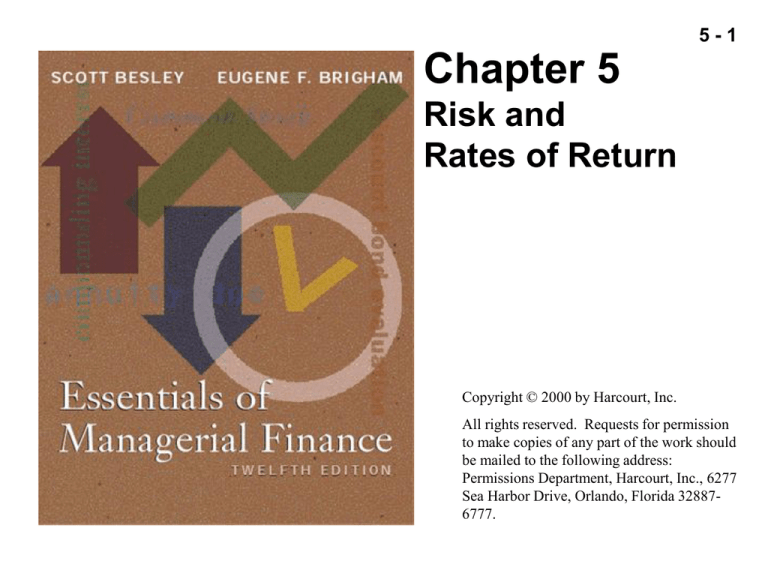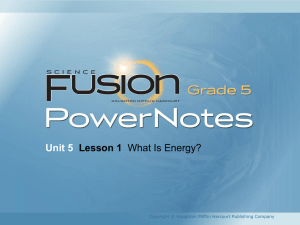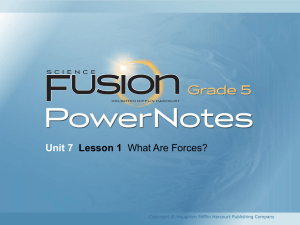
5-1
Chapter 5
Risk and
Rates of Return
Copyright © 2000 by Harcourt, Inc.
All rights reserved. Requests for permission
to make copies of any part of the work should
be mailed to the following address:
Permissions Department, Harcourt, Inc., 6277
Sea Harbor Drive, Orlando, Florida 328876777.
Copyright (C) 2000 by Harcourt, Inc. All rights
reserved.
5-2
Defining and
Measuring Risk
Risk is the chance that an outcome
other than expected will occur
Probability distribution is a listing of
all possible outcomes with a
probability assigned to each
[must sum to 1.0 (100%)]
Copyright (C) 2000 by Harcourt, Inc. All rights
reserved.
5-3
Probability Distributions
It either will rain, or it will not – only two
possible outcomes
Outcome (1)
Probability (2)
Rain
0.40 = 40%
No Rain
0.60 = 60%
1.00 100%
Copyright (C) 2000 by Harcourt, Inc. All rights
reserved.
5-4
Probability Distributions
Martin Products and U. S. Electric
State of the
Econom y
Boom
Normal
Recession
Probability of This State
Occurring
0.2
0.5
0.3
1.0
Rate of Return on Stock if
This State Occurs
Martin Products
U.S. Electric
110%
22%
-60%
20%
16%
10%
Copyright (C) 2000 by Harcourt, Inc. All rights
reserved.
5-5
Expected Rate of Return
The rate of return expected to be
realized from an investment
The mean value of the probability
distribution of possible returns
The weighted average of the outcomes,
where the weights are the probabilities
Copyright (C) 2000 by Harcourt, Inc. All rights
reserved.
5-6
Expected Rate of Return
Probability of
This State
State of the
Economy Occurring (Pr i)
(1)
Boom
Normal
Recession
(2)
0.2
0.5
0.3
1.0
Martin Products
Return if This State Product:
Occurs (ki)
(2) x (3)
(3)
110%
22%
-60%
^ =
km
= (4)
22%
11%
-18%
15%
U. S. Electric
Return if This Product:
State Occurs (ki) (2) x (5)
(5)
20%
16%
10%
^ =
km
= (6)
4%
8%
3%
15%
Copyright (C) 2000 by Harcourt, Inc. All rights
reserved.
5-7
Expected Rate of Return
ˆk Pr k Pr k ... Pr k
1 1
2 2
n n
n
Pri k i
i 1
Copyright (C) 2000 by Harcourt, Inc. All rights
reserved.
5-8
Continuous versus Discrete
Probability Distributions
Discrete Probability Distribution:
the number of possible outcomes is
limited, or finite
Copyright (C) 2000 by Harcourt, Inc. All rights
reserved.
Discrete Probability Distributions
a. Martin Products
Probability of
Occurrence
b. U. S. Electric
Probability of
Occurrence
0.5 -
0.5 -
0.4 -
0.4 -
0.3 -
0.3 -
0.2 -
0.2 -
0.1 -
0.1 -
-60 -45 -30 -15 0 15 22 30 45 60 75 90 110
Rate of
Expected Rate
Return (%)
of Return (15%)
-10
-5
0
5
10
16 20
Expected Rate
of Return (15%)
25 Rate of
Return (%)
5 - 10
Continuous versus Discrete
Probability Distributions
Continuous Probability Distribution:
the number of possible outcomes is
unlimited, or infinite
Copyright (C) 2000 by Harcourt, Inc. All rights
reserved.
Continuous
Probability
Distributions
5 - 11
Probability Density
U. S. Electric
Martin Products
-60
0
15
110
Rate of Return
(%)
Expected Rate of
Return Copyright (C) 2000 by Harcourt, Inc. All rights
reserved.
5 - 12
Measuring Risk:
The Standard Deviation
Calculating Martin Products’ Standard Deviation
Expected
Payoff Return
ki
k^
(2)
(1)
15%
110%
15%
22%
15%
-60%
ki - k^
(1) - (2) = (3)
95
7
-75
^2
(ki - k)
Probability
(4)
9,025
49
5,625
(5)
^ 2Pr
(ki - k)
i
(4) x (5) = (6)
1,805.0
0.2
24.5
0.5
1,687.5
0.3
Variance 2 3,517.0
Standard Deviation m m2 3,517 59.3%
Copyright (C) 2000 by Harcourt, Inc. All rights
reserved.
5 - 13
Measuring Risk:
The Standard Deviation
n
Expectedrateof return kˆ Pri k i
i 1
n
2
Variance k i - kˆ Pri
2
i 1
Standard deviation
2
n
i 1
2
k i - kˆ Pri
Copyright (C) 2000 by Harcourt, Inc. All rights
reserved.
5 - 14
Measuring Risk:
Coefficient of Variation
Standardized measure of risk per unit of
return
Calculated as the standard deviation
divided by the expected return
Useful where investments differ in risk
and expected returns
Risk
Coefficient of variation CV
Return
kˆ
Copyright (C) 2000 by Harcourt, Inc. All rights
reserved.
5 - 15
Risk Aversion
Risk-averse investors require
higher rates of return to invest
in higher-risk securities
Copyright (C) 2000 by Harcourt, Inc. All rights
reserved.
5 - 16
Risk Aversion and
Required Returns
Risk Premium (RP)
The portion of the expected
return that can be attributed to
the additional risk of an
investment
The difference between the
expected rate of return on a
given risky asset and that on a
less risky asset
Copyright (C) 2000 by Harcourt, Inc. All rights
reserved.
5 - 17
Portfolio Risk and the
Capital Asset Pricing Model
CAPM
A model based on the proposition
that any stock’s required rate of
return is equal to the risk-free rate of
return plus a risk premium, where
risk reflects diversification
Portfolio
A collection of investment securities
Copyright (C) 2000 by Harcourt, Inc. All rights
reserved.
5 - 18
Portfolio Returns
Expected return on a portfolio, ^
kp
The weighted average expected return
on the stocks held in the portfolio
ˆk w kˆ w kˆ ... w kˆ
p
1 1
2 2
N N
N
ˆ
w jk j
j1
Copyright (C) 2000 by Harcourt, Inc. All rights
reserved.
5 - 19
Portfolio Returns
_
Realized rate of return, k
The return that is actually earned
Actual return is usually different
from the expected return
Copyright (C) 2000 by Harcourt, Inc. All rights
reserved.
5 - 20
Returns Distribution for Two Perfectly
Negatively Correlated Stocks (r = -1.0)
and for Portfolio WM:
Stock W
Stock M
Portfolio WM
25
25
25
15
15
15
0
0
0
-10
-10
-10
Copyright (C) 2000 by Harcourt, Inc. All rights
reserved.
5 - 21
Returns Distributions for Two Perfectly
Positively Correlated Stocks (r = +1.0)
and for Portfolio MM:
Stock MM’
Stock MM’
Stock M
25
25
25
15
15
15
0
0
0
-10
-10
-10
Copyright (C) 2000 by Harcourt, Inc. All rights
reserved.
5 - 22
Portfolio Risk
Correlation Coefficient, r
A measure of the degree of
relationship between two variables
Perfectly correlated stocks rates of
return move together in the same
direction
Negatively correlated stocks have
rates of return than move in opposite
directions
Copyright (C) 2000 by Harcourt, Inc. All rights
reserved.
5 - 23
Portfolio Risk
Risk Reduction
Combining stocks that are not
perfectly correlated will reduce the
portfolio risk by diversification
The riskiness of a portfolio is
reduced as the number of stocks
in the portfolio increases
The smaller the positive
correlation, the lower the risk
Copyright (C) 2000 by Harcourt, Inc. All rights
reserved.
5 - 24
Firm-Specific Risk
versus Market Risk
Firm-Specific Risk
That part of a security’s risk
associated with random
outcomes generated by events,
or behaviors, specific to the firm
It can be eliminated by proper
diversification
Copyright (C) 2000 by Harcourt, Inc. All rights
reserved.
5 - 25
Firm-Specific Risk
versus Market Risk
Market Risk
That part of a security’s risk that
cannot be eliminated by
diversification because it is
associated with economic, or market
factors that systematically affect
most firms
Copyright (C) 2000 by Harcourt, Inc. All rights
reserved.
5 - 26
Firm-Specific Risk
versus Market Risk
Relevant Risk
The risk of a security that
cannot be diversified away,
or its market risk
This reflects a security’s
contribution to the risk of a
portfolio
Copyright (C) 2000 by Harcourt, Inc. All rights
reserved.
5 - 27
The Concept of Beta
Beta Coefficient, b
A measure of the extent to which the
returns on a given stock move with
the stock market
b = 0.5: stock is only half as volatile, or
risky, as the average stock
b = 1.0: stock is of average risk
b = 2.0: stock is twice as risky as the
average stock
Copyright (C) 2000 by Harcourt, Inc. All rights
reserved.
5 - 28
Portfolio Beta Coefficients
The beta of any set of securities is the
weighted average of the individual
securities’ betas
b p w 1 b1 w 2 b 2 ... w n b n
N
w jb j
j1
Copyright (C) 2000 by Harcourt, Inc. All rights
reserved.
5 - 29
The Relationship Between
Risk and Rates of Return
ˆk expected rateof returnon thejth stock
j
Copyright (C) 2000 by Harcourt, Inc. All rights
reserved.
5 - 30
The Relationship Between
Risk and Rates of Return
ˆk expected rateof returnon thejth stock
j
k j required rateof returnon thej stock
th
Copyright (C) 2000 by Harcourt, Inc. All rights
reserved.
5 - 31
The Relationship Between
Risk and Rates of Return
ˆk expected rateof returnon thejth stock
j
k j required rateof returnon thejth stock
k RF risk free rateof return
Copyright (C) 2000 by Harcourt, Inc. All rights
reserved.
5 - 32
The Relationship Between
Risk and Rates of Return
ˆk expected rateof returnon thejth stock
j
k j required rateof returnon thejth stock
k RF risk free rateof return
RPM k M - k RF marketrisk premium
Copyright (C) 2000 by Harcourt, Inc. All rights
reserved.
5 - 33
The Relationship Between
Risk and Rates of Return
ˆk expected rateof returnon thejth st ock
j
k j required rateof returnon thej st ock
th
k RF risk free rateof return
RPM k M - k RF marketrisk premium
th
RPj k M - k RF b j risk premiumon thej st ock
Copyright (C) 2000 by Harcourt, Inc. All rights
reserved.
5 - 34
Market Risk Premium
RPM is the additional return over the
risk-free rate needed to compensate
investors for assuming an average
amount of risk
Assuming:
Treasury bonds yield = 6%
Average stock required return = 14%
Then the market risk premium is 8
percent:
RPM = kM - kRF = 14% - 6% = 8%
Copyright (C) 2000 by Harcourt, Inc. All rights
reserved.
5 - 35
Risk Premium for a Stock
Risk Premium for Stock j
= RPj = RPM x bj
Copyright (C) 2000 by Harcourt, Inc. All rights
reserved.
5 - 36
The Required Rate of Return
for a Stock
k j required rateof returnfor stock j
k j k RF RPM b j
k RF k M k RF b j
Security Market Line (SML)
The line that shows the relationship
between risk as measured by beta and
the required rate of return for
individual securities Copyright (C) 2000 by Harcourt, Inc. All rights
reserved.
5 - 37
Security Market Line
SML : k j k RF k M k RF b j
Required Rate
of Return (%)
khigh = 22
kM = kA = 14
kLOW = 10
Safe Stock Risk
Premium: 4%
kRF = 6
Market (Average
Stock) Risk Premium:
8%
Relatively
Risky
Stock’s
Risk
Premium:
16%
Risk-Free
Rate: 6%
0
0.5
1.0
1.5
2.0 Risk, bj
Copyright (C) 2000 by Harcourt, Inc. All rights
reserved.
5 - 38
The Impact of Inflation
kRF is the price of money to a riskless
borrower
The nominal rate consists of
a real (inflation-free) rate of return
an inflation premium (IP)
An increase in expected inflation would
increase the risk-free rate
Copyright (C) 2000 by Harcourt, Inc. All rights
reserved.
5 - 39
Changes in Risk Aversion
The slope of the SML reflects the extent to
which investors are averse to risk
An increase in risk aversion increases the
risk premium and increases the slope
Copyright (C) 2000 by Harcourt, Inc. All rights
reserved.
5 - 40
Changes in a Stock’s
Beta Coefficient
The Beta risk of a stock is affected by
composition of its assets
use of debt financing
increased competition
expiration of patents
Any change in the required return
(from change in beta or in expected
inflation) affects the stock price
Copyright (C) 2000 by Harcourt, Inc. All rights
reserved.
5 - 41
Stock Market Equilibrium
The condition under which the
expected return on a security is
just equal to its required return
Actual market price equals its
intrinsic value as estimated by the
marginal investor, leading to price
stability
Copyright (C) 2000 by Harcourt, Inc. All rights
reserved.
5 - 42
Changes in Equilibrium
Stock Prices
Stock prices are not constant due to
changes in:
Risk-free rate, kRF
Market risk premium, kM - kRF
Stock X’s beta coefficient, bx
Stock X’s expected growth rate, gX
Changes in expected dividends, D0
Copyright (C) 2000 by Harcourt, Inc. All rights
reserved.
Actual Stock Prices and Returns
5 - 43
S&P 500 over 10 years
S&P 500
over 10 years
Copyright (C) 2000 by Harcourt, Inc. All rights
reserved.
5 - 44
Physical Assets
Versus Securities
Riskiness of corporate assets
is only relevant in terms of its
effect on the stock’s risk
Copyright (C) 2000 by Harcourt, Inc. All rights
reserved.
5 - 45
Word of Caution
CAPM
Based on expected conditions
Only have historical data
As conditions change, future
volatility may differ from past
volatility
Estimates are subject to error
Copyright (C) 2000 by Harcourt, Inc. All rights
reserved.
5 - 46
End of Chapter 5
Risk and
Rates of Return
Copyright (C) 2000 by Harcourt, Inc. All rights
reserved.









